Author: Ann Lee
Translator:Michelle X. Li
Introduction
At the beginning of the Pacific War between the United States and Japan, due to the influence of the “Chinese Exclusion Act” of 1882, the Chinese population in the United States was only about 100,000 people, and they suffered discrimination, unfair treatment and obstacles to naturalization for a long time. During World War II, between 13,000 to 20,000 Chinese were either volunteered or drafted into the army. In the famous 14th US Army Air Force, several logistic maintenance and intelligence squadrons were composed entirely of Chinese American soldiers, who proudly call themselves part of the “Flying Tigers”. The sacrifices and contributions made by these Chinese American troops in the China-Burma-India theater are little known, but we should never forget them. In December of 2018, the U.S. Congress decided to award gold medals to all Chinese American veterans in recognition of their contributions in World War II. This would be the greatest honor for these Chinese soldiers in their lifetimes.
Undeclared Pearl Harbor Attack
On December 7, 1941, a normal Sunday morning, the beautiful island of Hawaii was still in a peaceful slumber. The “Pearl Harbor US Army Base” at the southernmost point of Oahu was peace and quiet all around. No one was aware of the horror and chaos that were fast approaching…
The Combined Fleet of the Imperial Japanese Navy sent 353 aircrafts (fighters, level and dive bombers, and torpedo bombers) from six aircraft carriers and suddenly launched unannounced two waves of military attacks on Pearl Harbor US Army Base. The United States was caught completely by surprise and unprepared. The fire wave raided Pearl Harbor, and tens of thousands of bombs fell from the sky in an instant. Amid the wailing sirens, Pearl Harbor was immediately submerged in fire and smoke… 【1】

The Japanese Navy Air Force attacked Pearl Harbor of the United States, and the USS Arizona was bombed and destroyed
Source:https://zh.wikipedia.org/wiki/%E7%8F%8D%E7%8F%A0%E6%B8%AF%E4%BA%8B%E4%BB%B6
More than 20 of the U.S. Pacific Fleet’s cruisers and destroyers suffered heavy losses, among them the battleships Arizona and Oklahoma were sunk, 344 fighter jets were destroyed (188 destroyed, 155 injured). In addition, Kaneohe and Ewa airports were severely damaged, 2,403 Americans were killed and 1,178 injured. Naval officers and soldiers accounted for the majority of the casualties, followed by the army, and some civilians. 【1】
After the first wave of attacks, the commander of the Japanese Navy’s first group, Mitsuo Fuchida, excitedly transmitted the code words “Tora! Tora! Tora!”back to the carrier Akagi: the attack was successful!
The “Pearl Harbor Attack” shocked the entire nation, and Americans were furious about Japan’s undeclared attack. Before Pearl Harbor, America held an “isolationism”position regarding international conflicts, also called “neutrality”. However, the day after Pearl Harbor, President Franklin Roosevelt delivered the famous “Infamy Speech” to Congress, and signed a declaration of war against Japan. The Pacific War, one of the most important components of the Allied operations in World War II, began. 【2】

On December 8, 1941, US President Roosevelt delivered a speech to Congress
Source:https://zhuanlan.zhihu.com/p/67711049
The Japanese attack on “Pearl Harbor” severely damaged the US Pacific Fleet, causing major changes to the World War situation. In fact, Japan’s expansion into Southeast Asia started in the middle of 1941, which had generated dissatisfaction towards the Japanese in the occupied regions and countries. As a warning to the Japanese, the United States froze trade with Japan, including high-octane oil needed by air ships. In order to continue the aggression and plunder more oil resources, the Japanese decided to launch a desperate attack on the US fleet at Pearl Harbor, which prompted the United States to participate in the war and accelerated the demise of Japanese militarism.
After the United States declared war on the “Axis Powers” (Germany, Italy, and Japan), it launched a nationwide mobilization of war campaign at home and devoted its national strength to this worldwide anti-fascist war, from South to North and from East to West, powerful war machines began to operate…
As early as September 16, 1940, the United States restored the “Military Service Act”, also called “Selective Training and Service System” that was originally instituted during the First World War. This bill required all males between the ages of 21-36 to register, and the registered personnel would be selected by lottery. At the same time, it also stipulated that, except for special cases, all selected personnel must serve for 12 months and remain on the reserve list after being dismissed from active duty. However, after the United States officially entered the war, the age of service was revised to 18-65, and the service period was extended to 30 months. 【3】
In addition, the various U.S. personnel were vying to attract outstanding young people into the army. The following three U.S. Army Air Force recruitment posters were examples of images that made Americans feel the strong atmosphere of war and ambitiously stand up to defend the United States and world peace.
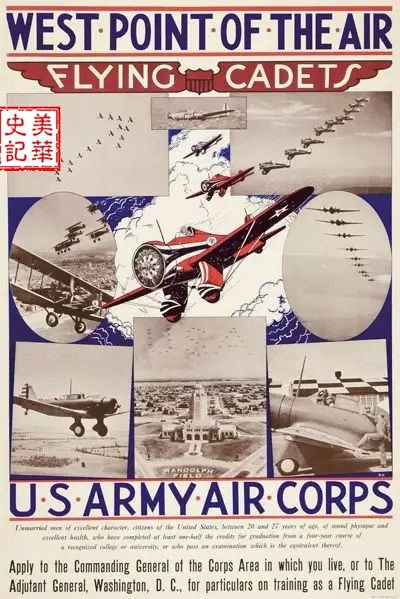
United States Army Air Corps (1940) recruiting poster
Source:https://www.sohu.com/a/270987324_457251

Let’s Go, U.S.A! Keep’em Flying! (U.S. Army, 1941)
Source:https://www.sohu.com/a/270987324_457251

US Army Air Force: O’er the ramparts we watch (Jes Schlaikjer 1944)
According to statistics, from the beginning of the conscription period to the end of World War II, a total of 35.5 million Americans in the United States had completed military service registration – more than one-third of the country’s population. Among them, 10.5 million put on military uniforms and went to battlefields in Europe, Asia, and Africa.【3】
“Chinese Exclusion Act” Victims went to the Front
However, in the early days of the war, Chinese Americans still suffered discrimination under the “Chinese Exclusion Act”. On May 6, 1882, Congress passed the “Chinese Exclusion Act”, prohibiting Chinese workers from entering the United States, stipulating that Chinese in the United States could not obtain citizenship, marry, or have a family…
This is the first time in the history of the United States that a discriminatory bill was formulated against a specific nationality or ethnic group. Over time, this bill was renewed multiple times and continued to impact the Chinese American community.
Because of the “Chinese Exclusion Act”, the total number of Chinese in the United States dropped to only about 100,000 when the United States entered the war in December 1941. At that time, the United States not only fought against the Japanese in the Pacific battlefield, but was also a major ally on the European and Asian battlefields. According to statistics from the US World War II Memorial: 【4】
During World War II, the number of the US military personnel surged from approximately 330,000 in 1939 to nearly 12.21 million in 1945. During this period, the total number of military servicemen was 17.88 million, where more than 13,000 soldiers were of Chinese descent.
The number provided by U.S. Army Center of Military History is also very close:【5】
When the United States entered World War II, about 29,000 persons of Chinese ancestry were living in Hawaii and another 78,000 on the mainland. By the end of WWII, over 13,000 were serving in all branches of the Army Ground Forces and Army Air Forces.
The Oakland Museum in California 【4】provided more detailed statistics:
The number of Chinese who joined the US military was 13,499, accounting for 22% of all Chinese men. 70% of them were incorporated into the 3rd and 4th Infantry Divisions of the European Theater and the 6th, 32nd, and 77th Infantry Divisions of the Pacific Theater; about 25% served in the Army Air Force.
The nationwide conscription and mobilization had a great impact on the lives of Chinese in San Francisco, California. At least 5,000 of the military servicemen were from Chinese families who had immigrated to the United States during the gold rush/construction of the transcontinental railroad, including the 2nd or 3rd generation ABC (American Born Chinese), as well as the so-called “Paper Sons”. The name“Paper Sons”was given to Chinese men who illegally immigrated to the United States by using fraudulent documentation to claim that they were related to someone who was a U.S. citizen. This was made possible because thousands of immigration files were destroyed as a result of the fire after San Francisco earthquake.
In July 1937, the Japanese army invaded most parts of China. Many Chinese families living in the United States had relatives back in their hometowns. The Japanese occupation of China brought countless sufferings and hardships to Chinese families on both sides of the Pacific Ocean. To make matters even worse, the Chinese in the United States had to suffer even more because of the “Chinese Exclusion Act”. The distrust and injustice towards the Chinese in American society was prevalent everywhere. Nonetheless, the Chinese responded to the government’s call and fought for the country heroically and with the same patriotic passion as their fellow Americans. Also, compulsory military service was in effect at that time.
These were the primary reasons why many Chinese Americans actively served in the war.
Henry Lim, now 96 years old, was only 19 when he was drafted. He said in an interview: “My mother was very sad when I got drafted because, according to Chinese tradition, she believed that her son would never come back once he joined the army”. But Mr. Lim said: “You got to go, you had to go”. 【8】
Like many other Chinese who joined the army, Henry Lim grew up in Chinatown and received his high school education in the United States. He was eager to leave Chinatown and explore the beautiful world beyond Chinatown. The opportunity to “Fight for the United States” opened a door for these young people to serve the country, and provided them with a hope that they would be treated equally and could receive US citizenship, and that ultimately they would help improve the lives of their families. So, they left their parents and joined the army with great determination.
During World War II, many Chinese Americans served in the nine maintenance and service squadrons of the 14th Air Force in the CBI Theater. Some squadrons, such as the 407 and 555 aviation ground maintenance teams, the 987 special communications company, the 1157 signal team, the 1077 supply team, the 1544 and 1545 arms, 2121 and 2122 cargo teams, etc., all team members were of Chinese descent. 【8】
After the United States declared the war on Japan, the “American Aviation Volunteer Group” (AVG) that entered China previously was disbanded, and the “Flying Tiger” commander General Chennault was promoted to the commander-in-chief of the 14th Air Force. The well-known name of “Flying Tigers” had also been inherited. The Chinese American members who served in maintenance and service squadrons also proudly call themselves “Flying Tigers”.
More than fifty years later, the descendants of a 407 squadron veteran published a book “In the Shadow of the Tiger”. The book recounted these Chinese American veterans’ experience, photos, and memories in the battlefields when serving in the US military. These little known stories about the Chinese American servicemen in the CBI Theater were a valuable part of Chinese American history and should not be forgotten.
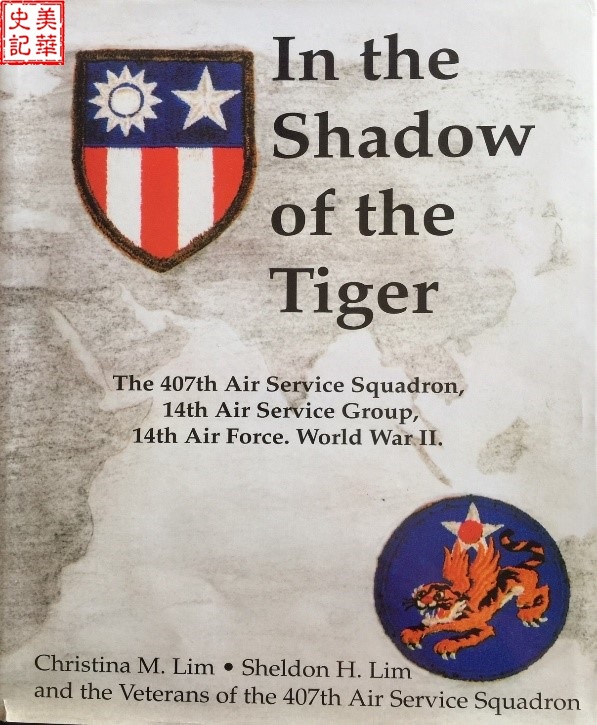
《In the Shadow of the Tiger》
Authors:Christina M. Lim & Sheldon H. Lim and the Veterans of the 407th Air Service Squadron
The author of the book wrote affectionately in the introduction:
Fifty years ago, we began the adventure of a lifetime. For many of us, it was the first time we had traveled away from our families beyond the Chinatowns scattered throughout the United States. Our journey would take us around the world from Springfield, Illinois, across the Atlantic Ocean, through the Middle East, then the near east to China, the homeland of our ancestors, and back across the Pacific Ocean to Tacoma, Washington. We would experience the inequities of life in America and in the United States Armed Forces, and witness the tragedy and sadness of war.
The author reiterated: The purpose of publishing this book was in no way to praise the war. It was to tell these experiences to the young generations, and to organize the stories of the 407 Squadron into a book dedicated to those who once fought for the United States but had passed away.
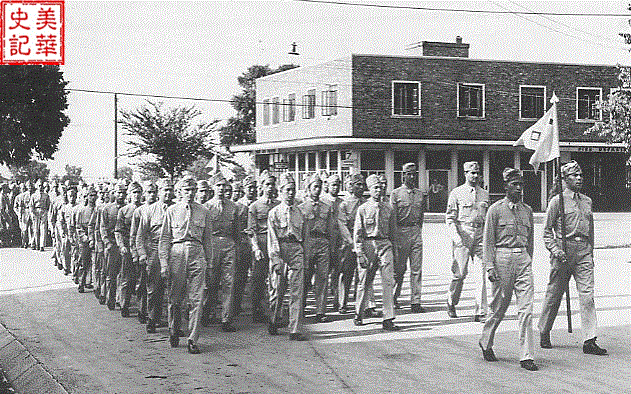
In June 1943, 407 Squadron was established in Springfield, Illinois (Springfield)
Source:http://www.flyingtiger-cacw.com/gb_228.htm
Cross the Oceans to the Battlefield of CBI
After the United States entered the war, at the request of Brigadier General Claire Chennault, Commander of the Chinese Air Force Task Force, and Lieutenant General Joseph W. Stillwell, Commander of the U.S. Army in Burma, the United States and Chairman Chiang Kai-shek reached a consensus in establishing an Army Air Service unit composed of Chinese-Americans who were proficient in both English and Chinese. 【9】
The maintenance and service departments of the 14th Air Force were assigned to perform various professional tasks, such as delivering military supplies, providing transportation, coordinating communications, etc. These tasks ranged from providing toothpaste and fresh uniforms to providing the fuel, parts, ammunition and bombs needed for aerial combat. In addition, the well-trained Chinese mechanics from the 407th and 555th squadrons were responsible for the most important task – aircraft maintenance to ensure the uninterrupted operation of all aircrafts.
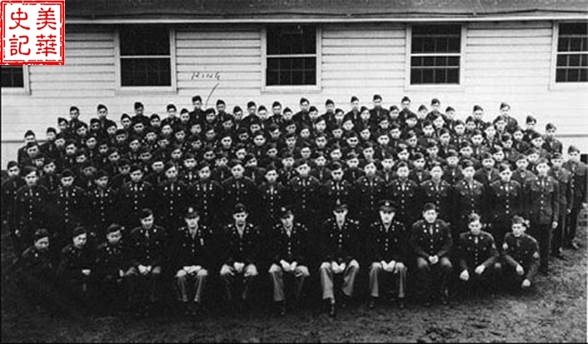
Group photo of the All-Chinese 407th Air Service Squadron of the U.S. Army in 1943 (Photo: Public Domain)
Source:https://share.america.gov/zh-hans/wwii/
The 407 Squadron was established in June 1943 in Spring Field, Illinois. The 260 members of the squadron came from various states, with very different educational and professional backgrounds. Members included high school graduates, individuals with PhDs who previously worked as doctors, famous journalists (William Hoy), electricians, Chinese restaurant chefs, hairdressers, etc. The members’ ages also varied greatly.
In June and July 1943, all members of the 407 Squadron received basic military training in Springfield. Then in August, they were transferred to Patterson Field, Ohio for technical training on aircraft repairs and other techniques, such as Engines, fuselages, hydraulic presses, instruments, electrical repairs, etc. Such technical training in the military equipped these Chinese soldiers with important skills that were beneficial later in life.
In an interview in the documentary created by CHCP (Chinese Historical & Cultural Project), 407 squadron veteran Richard Wong mentioned: “When assigning specific types of work, each of us would take related IQ tests to determine whether we could be qualified for the highly demanding technical training.”
Richard Wong, who grew up in San Francisco, was responsible for repairing damaged aircrafts, including patching holes that were hit by Japanese guns. He was also asked to destroy airplanes that were beyond repair: he would first remove all the parts that could be reused, such as radios, tires, instruments, wings, weapons, etc., then he poured gasoline and burned the remains of the aircraft.
This kind of training lasted for nearly a year. In April 1944, he was sent to the port of Newport News, Virginia, and then left the United States by boarding a ship. It was a very dangerous journey sailing across the Atlantic Ocean, because they had to stay high alert and vigilant to avoid attacks from the German submarines. However, when they arrived safely at the port of Oran, Algeria, North Africa, they accidentally collided with another ship entering the port. The Collision left a big hole on the ship and the ship had to be scrapped, fortunately, there were no casualties. All passengers from the ship had to stay in tents, and waited for a long time until a British troop carrier came to take them to Bombay, India, a British colony at that time. That was a long journey, passing through several Middle Eastern countries, the Mediterranean, the Suez Canal, and the Red Sea. From Bombay, the soldiers were transported to their final destination: Kolkata, India. 【7】
This long journey circumnavigated most of the Earth and traveled thousands of miles from west to east. It lasted more than 40 days and presented various challenges to the new recruits. The reason that they chose this route was to avoid attacks from the Japanese submarines and planes while the Pacific War was in full swing at that time.
After arriving in Kolkata, these soldiers were assigned to work at the Dinjan, Assam Airport in the province of Assam in southern India close to Myanmar. This airport became the starting point of the famous “Hump Route”, sending cargo planes loaded with various military materials 24 hours a day and every day to China. Sadly, some of these planes flying to Kunming China fell into the icy and snowy deep valley before reaching their destination…
Richard Wong told the interviewer: After serving at Dinjan Airport for about six months, on November 30, 1944, all the squadrons flew over the Himalayas and arrived at the Kunming Wujiaba Airport in Yunnan Province, China. On the same night, they were bombarded by a Japanese plane when they were having dinner. Fortunately, there were no casualties. 【10】
Soon after being stationed in Kunming, the troops moved to Luliang, a new airport in the southwest region built for the large B-29 bombers. The 407 squadron was divided into several detachments. One of the detachments was sent to Luoping. On the 2nd day they arrived at Luoping, they heard the news that the Japanese army had invaded Guilin and burned down their dormitory, then they had to return to the division immediately. Later, the 407 squadron was divided into six detachments and went north to defend the airports along the Yellow River, including Xi’an, Hanzhong, Laohekou, Enshi, and Ankang, while the headquarter was stationed at Baishiyi Airport on the outskirts of Chongqing. In addition to the US 14th Air Force, the 407 squadron also provided essential aircraft maintenance services for the “Chinese American Composite Wing” (CACW). 【7】
Lin Rixin, a Taishan veteran of 407 Squadron, was transferred to Hebei Laohekou Airport, which was less than 100 miles away from the Japanese occupation area. Japanese planes flew in every night to drop off bombs. Recalling these horrible days, Lin Rixin told reporters that “the Japanese sent planes once every two hours, three or four times a night, and almost every night.”
Later, they started to fight back and shot down one Japanese plane every day for five consecutive nights. Then, the Japanese dared not to come again. After the Japanese surrendered and the war was over, Lin Rixin had an opportunity to pass by the Japanese military airport and saw only one Japanese plane parked there. Only then did he realize how heavy the Japanese loss was.
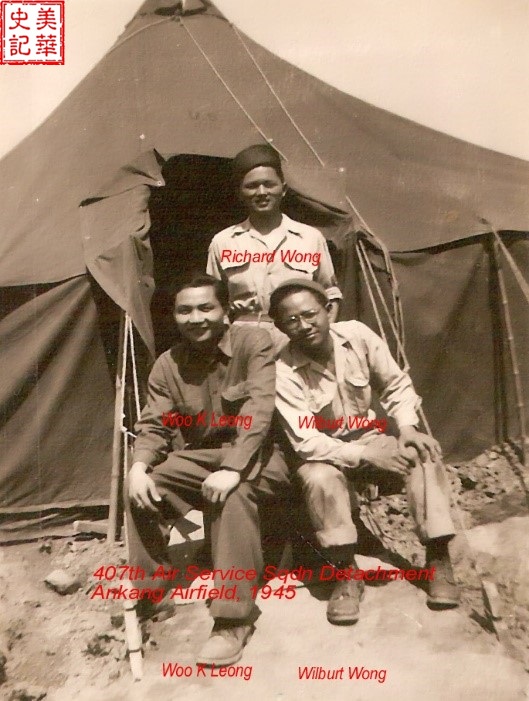
Richard Wong (rear stander) and his comrades of 407 Squadron at Ankang Airport, China (1945)
Source:https://www.huffpost.com/entry/chinese-american-wwii-vets_b_989073
The records of the 407 Squadron and the memories of the Chinese veterans had shown us the great contributions made by these Chinese soldiers through their life-and-death journey in the war more than seventy years ago!
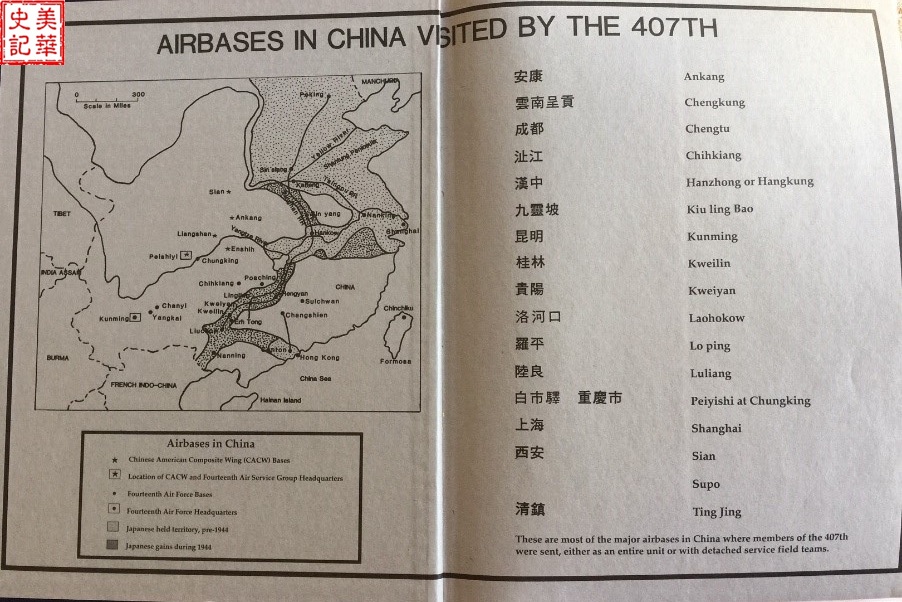
Airbases in China visited by the 407th
Source:《In the Shadow of the Tiger》
Flew over the Hump 38 Times to Send the Supplies
In addition to the 407 Squadron, Chinese American soldiers were fighting at the forefront everywhere in the China-Burma-India Theater …
Rongfu Li, a 97-year-old Chinese-American veteran, was born in Taishan, Guangdong, and came to the US when he was 15. At the age of 19, he was enlisted in the army. After taking a test, he was sent to a military school in Illinois to study radio. After graduation, he was assigned to the third combat supply aviation squadron of the 14th Air Force and became a telegraph operator on the C-47 cargo planes. He was the only Chinese in this squadron.
In 1942, the Japanese occupied Lashio, Myanmar and cut off the Burma Road to stop supplies from the Allies to China. In order to provide supplies to China and support the fight against the invaders in China, one air route was opened from India to Kunming, China. This air route had transported much needed weapons, ammunition and military materials to China from April 1942 to August 1945. This air route was known to be the most dangerous one in the world. On one hand, the cargo planes often risked being attacked by Japanese fighter jets as there were no fighter jets escorting them. Once attacked by the Japanese, the ending would be disastrous. During this period, many cargo planes were shot down, or severely damaged. On another hand, the very harsh weather conditions (windy and snowy) in the mountains and valleys presented even greater challenges to these cargo planes. This route was therefore dubbed the “Hump Route” by American pilots. It was also the first continuous, year around, and all-weather military air supply lifeline in the history of world air transportation.
“We were lucky, because we had never been attacked.” Rongfu Li recalled.
He and his comrades usually loaded their cargo planes at the Chittagong wharf in India, then flew over the Himalayas to Kunming. Sometimes they flew directly to the battlefield front line and air-dropped the supplies. For a period of time, Rongfu Li and his comrades transported American mules to Kunming. These mules were used to transport weapons, ammunition and military supplies before the Burma Road was repaired. Whenever there was a need from the frontline, they would fly the supplies to these places: Guilin, Hainan Island, Haiphong, Nanning… They answered every order with no hesitation, and they treated every flight mission as their last one. 【11】
According to Air Force regulations, one would receive an award if he flew over the “Hump” 30 times. Chinese veteran Rongfu Li flew the “Hump” 38 times during his service. To recognize his outstanding service on the battlefield, he was awarded four US Medals of Honor.
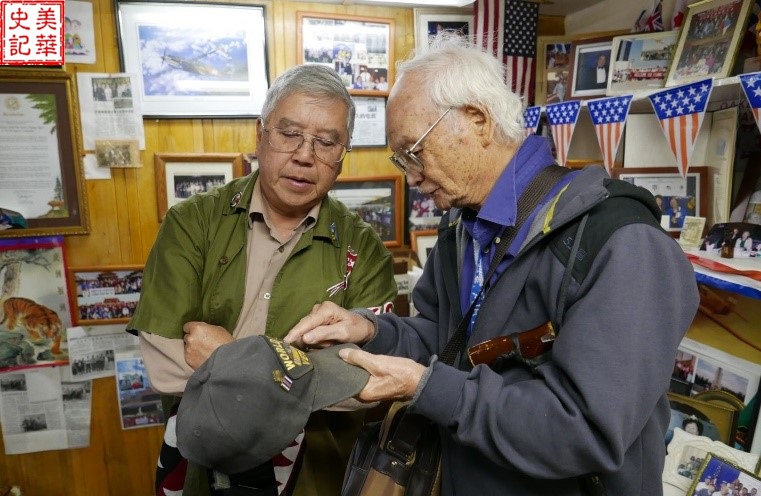
“Flying Tiger” veteran Rongfu Li (right) and other Chinese veteran descendant
Source:picture taken by author
Wear a “Blood Chit” go to the Battlefield
Veteran Chongyun Zhen was born in Sijiu Town, Taishan, Guangdong in 1922. He came to the United States in 1932. Ten years later (1942), he was drafted into the army and became a communications officer in the 987 Special Communications Company of the 14th Air Force.
As a division of the US Army Signal Corps, the 987th Signal Company was formed to specifically serve China, providing communication services and strengthening the liaison between Chinese and US military organizations. All members of the 987th Signal Company were bilingual Chinese-American soldiers.
Chongyun Zhen spent 18 months at the Missouri military base and received training in radio transmission and reception technology, as well as interception and decryption of Japanese military telegrams. Then, he traveled by ship to the China-Burma-India theater along with his troops.
Chongyun Zhen recalled that their ships had no fleet escort when navigating across the Pacific ocean; therefore, their ships had to travel in a zigzag pattern and change their course every 10 minutes to avoid being attacked by the Japanese submarines. Even with such caution, two of the three troop carriers that departed from California were attacked and sank.
As soon as the 987 Special Communications Company entered China, it set up its headquarters in Kaiyuan City, south of Kunming (now Honghe Hani and Yi Autonomous Prefecture in Yunnan) and started to provide support services immediately. The team had a total of 184 members; all were Chinese except 8 officers. Starting from Kaiyuan, they were divided into smaller teams with two to four members and were sent to various remote areas. They provided great assistance in communications between the US Army Wing and the Chinese Army troops deployed on the Indochina border occupied by the Japanese. 【12】
The location of the communication unit and its radio station was “super secretive” at the time. Each radio station was equipped with a self-destructive device. When an enemy was found within a 15-mile radius of the radio station, the radio’s self-destruction device would be activated.
After arriving in China, they immediately changed into a military uniform embroidered with a “blood chit”, a special badge attached inside of their clothes indicating that they were soldiers from America to help the Chinese. Chongyun Zhen recalled that it was difficult to distinguish between Chinese soldiers and Japanese soldiers from their appearance. Therefore, Chinese soldiers in the 987 Special Communications Company would wear “blood chits” on their uniforms so that the Chinese soldiers and civilians would rescue them in case they were injured on the battlefield.
In 1945, Chongyun Zhen and his comrades entered Vietnam on missions to investigate and verify whether the Japanese troops stationed nearby were transferred and the military intentions of the transfer. In addition, they transmitted a large number of radio signals for the Allied forces to falsify Allied forces movements to confuse the enemy. They also provided radio communications for the intelligence agents from the Allied forces who were working in the Japanese-occupied area. Thanks to their accurate intelligence and timely military supplies, the Allied forces defeated the Japanese in several key battles including western Yunnan, and contributed greatly to the final World War II victory.
A team of 4 radio communication soldiers, 3 Americans, and more than a dozen Chinese soldiers carried out this mission. An American military doctor gave each person two pills and told them: If they were caught by the Japanese, they should swallow the pills immediately, then they would die in a few seconds without any suffering and would also avoid being tortured by the Japanese. Fortunately, they successfully completed the mission and didn’t need the “suicide pill”!
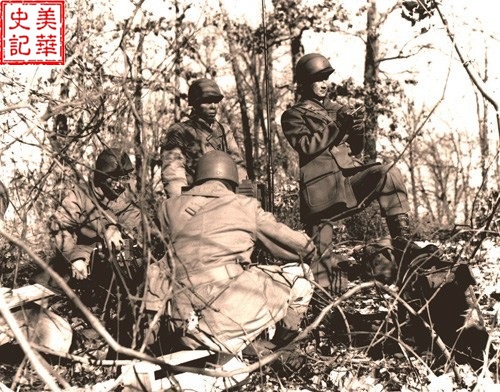
In 1943, 987 Special Communications Company conducted field training in Missouri (Crow Crowder)
Source:Provided by Christina Lim
Decades later, Flying Tigers receive a hero’s welcome at home in Seattle
Otherwise, we would not have had the opportunity to hear these astounding battlefield stories from our veterans today.
In the CBI Theater, Chongyun Zhen was awarded the bronze medal of “Courageous Achievement” by the United States military for his outstanding accomplishments. He was one of the only 4 soldiers who received this high honor in the entire 987 special communications company during their service in the war zone.
More than sixty years later, veteran Chongyun Zhen donated all 10 medals and 4 badges he won in World War II to his hometown Museum in Taishan, Guangdong Province. These precious photos, medals, and stories allowed the younger generations born in peaceful times to learn the heroic contributions from the Chinese servicemen on the China-Burma-Indian battlefield. 【13】
Three Chinese Brothers Joined the Army to Serve the Country)
Wing Y Lai, a retired veteran of the 14th Air Force 555 Squadron, was born in Chinatown of San Francisco in January 1925 and grew up there. Before he joined the army, the farthest place he had ever traveled away from home was to visit the World’s Fair on Treasure Island, San Francisco in 1939.
When the United States entered the war, Wing had just graduated from high school. One day he received a letter from the local recruiting office, notifying him that he had been selected for military service through a lottery draw system.
Wing’s father ran a family business in cigarette wholesale in San Francisco Chinatown, and his siblings all helped around. Before Wing was recruited, one of his older brothers had already been selected by the Recruitment office and deployed to Alaska which was closest to Japan, defending the United States from attacks by Japanese planes. Wing’s other elder brother volunteered to be a fighter jet pilot, but was disqualified because of his color blindness when he arrived at the Tucson Flight Training Base (Tucson, AZ). Then he joined the 43rd Intelligence Squadron of the US Air Force.
The family had sent two sons to the army. Now, they received another notification letter. Even though it was not an easy thing for his parents, Wing joined the army with no hesitation!
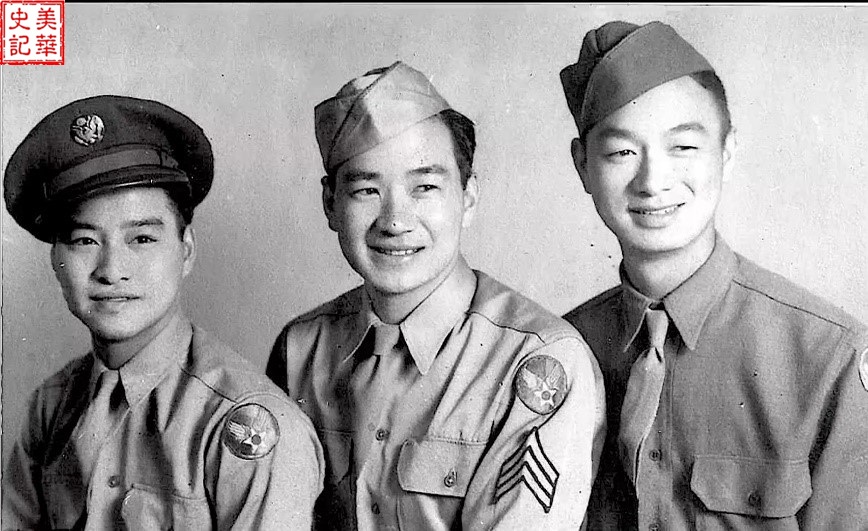
Three brothers went to battlefield(Jow, CBI; Chor, Alaska; and Wing Lai, CBI)
Source:Documentary“Tiger Sprit – Chinese American WWII Veterans of the China-Burma-India Theatre”(by CHCP)
Wing Y Lai was only 18 years old when he reported to Fort Ord at the California Outpost of the U.S. Army to receive military training.
Even now, he still can’t forget the first night he arrived at the barracks. He had never been more than five miles away from home, so this completely new world made him very scared, and he worried what kind of future would be waiting for him. In the end, he cried himself to sleep.
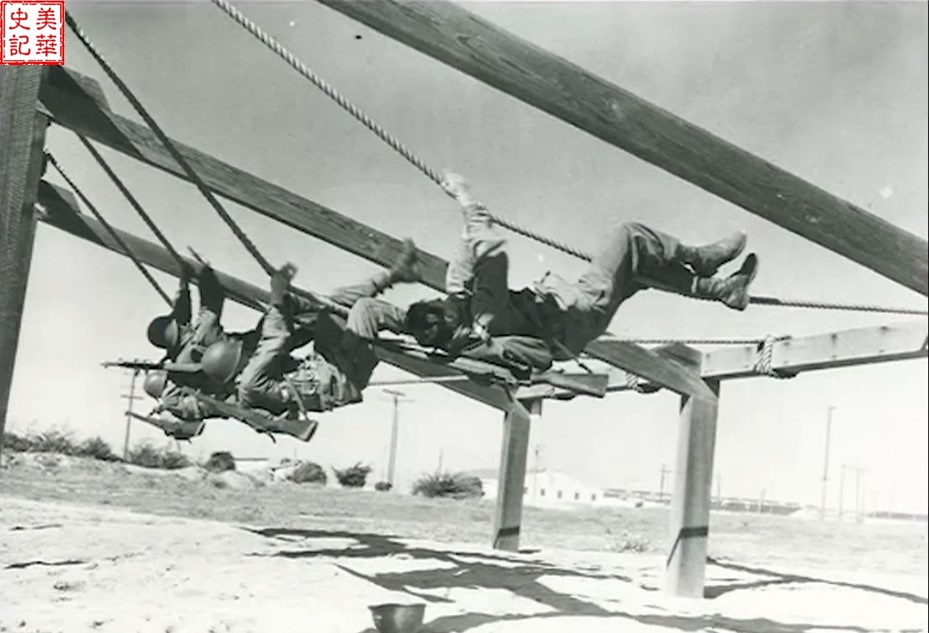
Enlisted recruits at basic military training
Source:Documentary“Tiger Sprit – Chinese American WWII Veterans of the China-Burma-India Theatre”(by CHCP)
When Wing Y Lai arrived at the 555 Ground Service Repair Squadron, there were only two or three Asians, and he was the youngest member of the team. Although he felt discriminated against in the beginning, he got along well with everyone later on. After completing a six-week basic training, he was sent to Redding, CA to learn pistol and rifle shooting techniques. He also learned to drive a variety of vehicles, from jeeps to large trucks. As a fresh high school graduate, it took a while for him to get used to the strict and intense military training.
After Redding, CA, the 555th Maintenance Squadron was sent to Springfield, Illinois for other types of military training, then continued training in Venice, Florida for about six months.
In 1944, Wing Y Lai was sent to India along with other 555 squadron members. It was a difficult and long journey, and it was even farther away from home!
After the 555 squadron arrived in India, they were assigned to train Chinese mechanics on aircraft maintenance. One day, the supervisor found out that Wing could type very fast, so then he was put in charge of ordering aircraft parts for all departments.
According to the U.S. military’s original plan, the Chinese American soldiers sent to China would help improve the communication between the U.S. military and the locals. What they didn’t know was that these young soldiers from Chinatown didn’t speak “Mandarin” at all, and some of them even couldn’t speak “Cantonese” well. They had to rely on hand gestures for communication when working with their Chinese counterparts. Despite the language barriers, the Chinese military and civilians were very kind to the US soldiers, and they were grateful to the American military for what they had done for China. The Chinese American soldiers were also very impressed by the hard-working and brave Chinese soldiers and civilians. It was particularly memorable to witness thousands of Chinese soldiers and civilians building the Burma Road and airport with the most primitive tools.
In the CBI Theater, even not in the front line of the battlefield, they still faced many dangers. The Burma Road had many sharp turns which made driving extremely difficult. One day, after driving ten miles, they heard gunfire nearby and everyone was terrified. Even at the barracks, gunshots were often heard and ferocious beasts were often seen at night. Therefore, they had to remain vigilant all the time, and got up early to avoid the trouble. Afterarriving in China,they encountered similar situations, especially the unexpected airstrikes. Everyone had to stay alert and be very careful.
Chinese Veterans of World War II Won the Gold Medal
During World War II, China and the United States formed an alliance and jointly fought against fascism. The US media began to declare that the “Chinese are our friends!” Prior to this, Chinese Americans living in Chinatown were considered as “cheap labor” and “little pigs.”
In early 1943, Madam Song Meiling (March 4, 1898-October 24, 2003) gave seven speeches to the U.S. Congress and several other cities, calling on the American people to support the Chinese war of resistance against Japan. Her speeches drew a whirlwind sensation throughout the United States. 【14】
On December 17 of the same year, thanks to the unremitting efforts of Pearl Buck and many other Americans, with the support of President Roosevelt, Congress passed the “Magnuson Act”, abolishing the “Chinese Exclusion Act” of 1882 and opening Chinese immigrants and naturalization. 【15】 Although there were still many restrictions on the number of immigrants, e.g. only 105 Chinese immigrants were allowed to enter the United States every year, and Chinese were not allowed to purchase real estate properties, it was still a small step forward. For a while, many Chinese were encouraged to take advantage of becoming American citizens through military service, a significant surge of Chinese enrollment in the army was evidenced in Chinatowns of many major cities across the US. 【6】
After years of arduous battles fought jointly by the Chinese and American military and civilians, the Pacific War situation improved significantly. Especially in August 1945, the US dropped two atomic bombs on Hiroshima and Nagasaki, and the Soviet Union also declared war on Japan, which forced desperate Japan to finally surrender.
When the news of victory arrived, the Chinese and American soldiers of the 14th Air Force danced and sang happily. The air base was full of joy… The war was over, and they could finally go home!
Sadly, Wing Y Lai’s elder brother who volunteered to join the Air Force never returned home.
He was one of the three soldiers who died in a small US military plane crash on their way to Kunming. He was only 23 years old.
After the war ended, the 407 Squadron was sent to Hunan to secure the Zhijiang Airport so that Japan and China military commanders could sign a truce there. After all handover procedures were completed in December, they flew to Shanghai and boarded a US warship heading home. They made a brief stop in Tokyo, Japan, then arrived at Seattle, Washington on Christmas Day in 1945, which marked the completion of the War of Resistance and the entire 407 Squadron officially retired from the military.
More than seventy years have passed since the end of WWII. To honor the Chinese Americans who served in the war, a large memorial plaque in the public square of San Francisco Chinatown lists the names of more than 100 Chinese Americans who gave their lives in service to their country, including Wing Y Lai’s brother who died in a military plane crash. Wing’s brother and his two fellow soldiers were later buried in the Golden Gate National Cemetery in San Francisco.
Veteran Wing Y Lai once suggested that the memorial plaque be moved to a square where more people could see it. He sighed: “Many tourists come to visit San Francisco, but they, including some locals, don’t know that many Chinese Americans served in World War II and some of them never came back.”
The most touching story is that every time he goes to San Francisco, he would bring a white chalk with him. To pay his tribute at the Chinese American Army World War II memorial plaque, he always affectionately traces over the names of his brother (Tammy Jow Lai), brother-in-law (Clinton Lok), and their two friends (Edward D. Quong and Faye Lowe) with the white chalk.
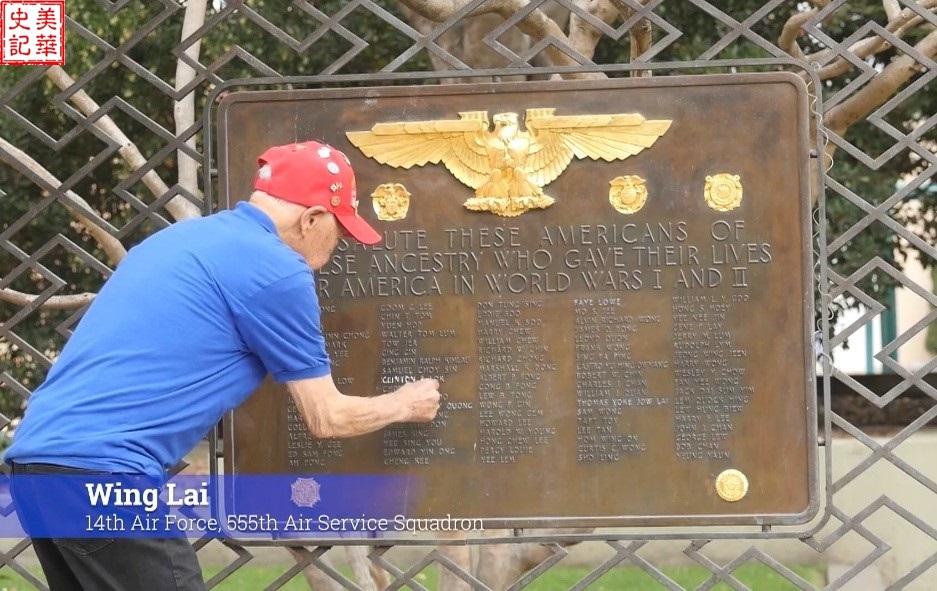
World War II veteran Wing Y Lai uses chalk to draw the names of the Chinese soldiers who died in the war
Source:Documentary“Tiger Sprit – Chinese American WWII Veterans of the China-Burma-India Theatre”(by CHCP)
On the Plaza of the City Hall of Monterey Park, California, there is also an “American & Chinese World War II Memorial”, with this message solemnly engraved on the monument:
“Dedicated to the American and Chinese military and people who gave up their lives during the Second World War to defend freedom and justice of mankind against aggression.”
This is the first overseas monument to commemorate the Chinese and American soldiers and civilians who fought side by side against the Japanese aggressor. It is an eternal testimony of the two countries working together to maintain world peace, and it also symbolizes the friendship between the Chinese and American people.
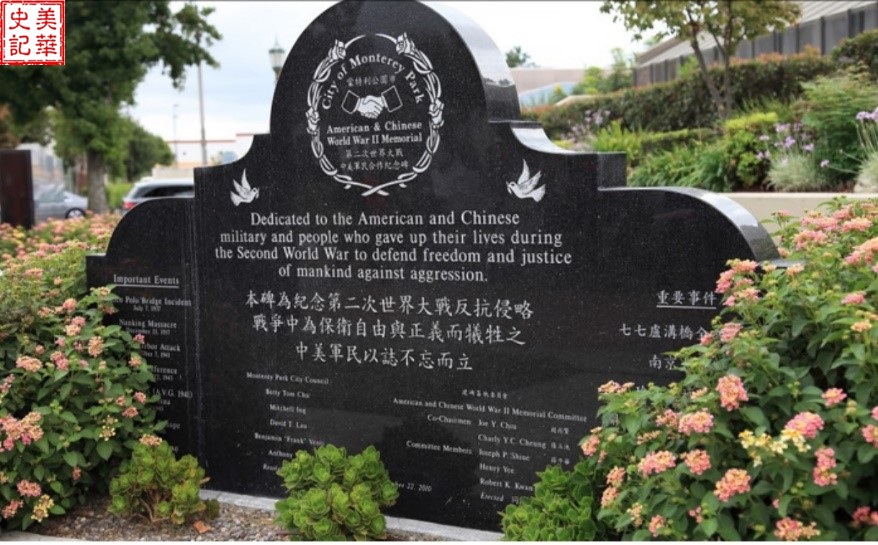
On November 22, 2010, Monterey, California established the “American & Chinese World War II Memorial”.
Source:http://www.chinesenewsusa.com/news/show-26249.html
General Douglas MacArthur, the commander-in-chief of the US Balance Ocean Fleet, quoted an old army ballad: “Old soldiers never die – they just fade away” in his farewell address to congress in 1951 to describe a true soldier. Also, in his inspirational speech “Duty, Honor, Country” at West Point Military Academy in 1962, General MacArthur said: “The soldier above all other people, prays for peace, for he must suffer and bear the deepest wounds and scars of war.”【16】
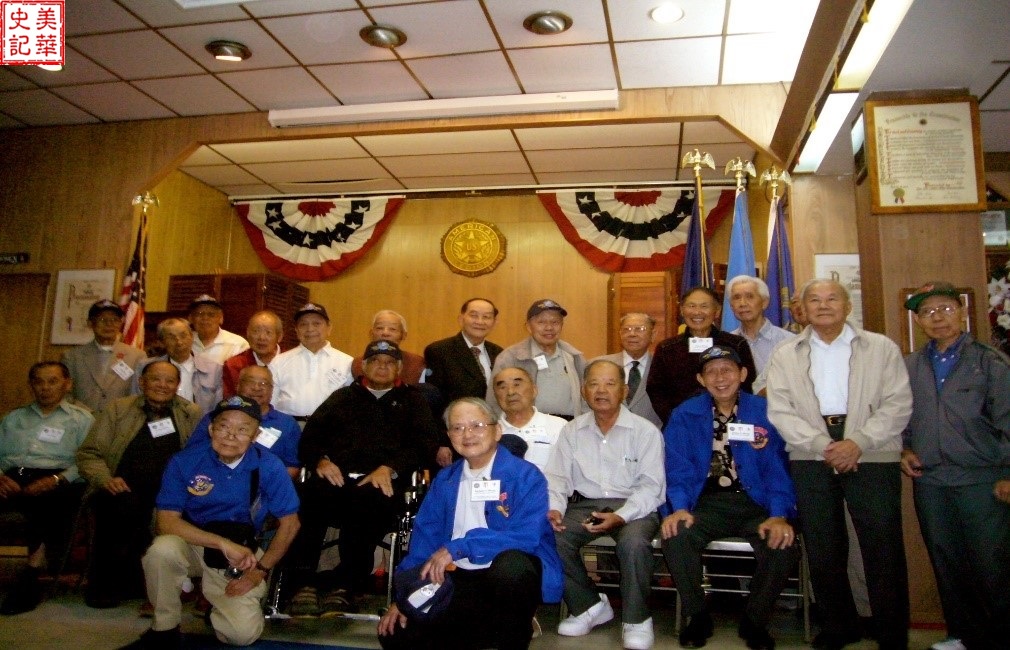
California Chinese American Veterans Gathering in 2013
Source:CHCP – Chinese Historical & Cultural Project
As time goes by, more and more WWII veterans have passed away. However, their history has not disappeared. Their legendary stories will continue to inspire future generations to remember history and defend world peace.
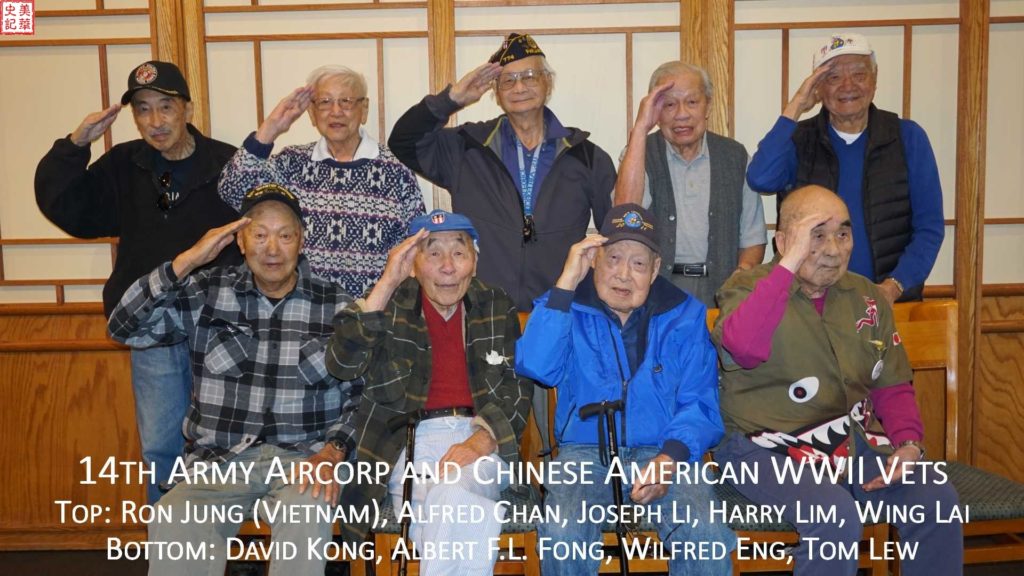
California Chinese American Veterans Gathering in 2019
Source:CHCP – Chinese Historical & Cultural Project
Recalling those turbulent years, the Chinese veterans feel honored for the opportunity to support the brave Flying Tigers, and are very proud of serving in the US Air Force. Although it was a very dangerous journey, it enabled them to explore the world beyond Chinatown and to meet people from different backgrounds. What they cherish the most are the lifelong friendships established among their comrades.
After years of tireless efforts by many Chinese American veterans and civil rights activists, the U.S. Congress unanimously passed the US Senate S.1050 and US House of Representatives HR2358 bills on December 12, 2018, and the U.S. government awarded nearly 20,000 Chinese veterans for their contributions in World War II. The Chinese American veterans of WWII finally received their much deserved recognition, more than 70 years after the end of the war.
On January 29, 2019, the Congressional Gold Medal Ceremony for Chinese-American World War II Veterans was held at the Department of Veterans Affairs in Washington, DC. As the co-chairs of the White House Initiative on Asian Americans and Pacific Islanders, U.S. Secretary of Transportation Elaine L. Chao and U.S. Secretary of Education Betsy DeVos delivered remarks at the event. James Byrne, General Counsel of Veterans Affairs hosted this event. They commended the five representatives of Chinese American Veterans with high remarks and thanked all Chinese Americans who fought bravely in World War II.
Elaine L. Chao commented in her speech: “Today we are telling the story of our Chinese Americans, and it is also a story that has not been mentioned much in the mainstream media in the United States… The United States and younger generations need to know more about the Chinese American community and generations of courageous and patriotic Chinese Americans who have made great sacrifices and contributions to build and defend our country.” 【17】
In her speech, Chao brought up an important fact. During World War II, the negative impact of the “Chinese Exclusion Act” was still widespread. Although many Chinese Americans suffered various social discrimination, injustice, and obstacles to naturalization, more than 13,000 Chinese joined the US army and fought the anti-fascist war without hesitation. They accounted for 17% of the total number of Chinese in the United States at the time and were one of the ethnic groups with the highest percentage of its population who served in the war for the United States. Nearly 20% of these Chinese soldiers died overseas. In addition, 40% of Chinese military personnel were not citizens, and they were not approved for naturalization until the end of the war. 【17】
These Chinese veterans are very proud to have been awarded the gold medal by the US government. The story of their sacrifices, service and dedication in the war needs to be more widely acknowledged.
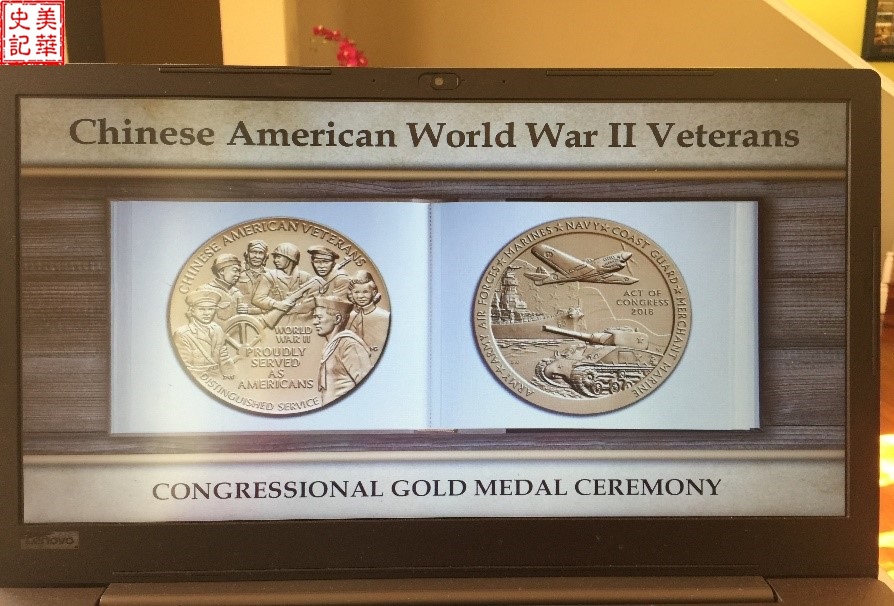
On December 9, 2020, a virtual congressional gold medal award ceremony to commemorate the Chinese veterans of WWII in the United States
Source:Picture taken by author
On December 9, 2020, seventy-five years after the end of World War II, a “Congressional Gold Medal Ceremony for Chinese-American World War II Veterans” was held to commend thousands of Chinese Americans who served the United States during the war. Due to the impact of the Covid-19 pandemic, the ceremony, originally scheduled for April in Washington, D.C., had to be postponed to December and changed to a virtual one. Despite these unexpected changes, the importance and significance of this ceremony will be profound and long lasting.
The conference was led by U.S. House Speaker Nancy Pelosi. Leaders from both democratic and republican parties, generals of the army, navy, and air force, and representatives from the House and Senate delivered compelling speeches. Representative Mark Takano, Chairman of the House of Representatives Committee on Veterans Affairs, summarized the theme of this conference in his remarks: “Despite coming from different backgrounds, Chinese American service members fought alongside their fellow Americans with a shared love for their country. Because of this high honor, we shall tell a more complete story about what happened during the Second World War…”
The purpose of commemorating the Chinese soldiers is not to celebrate the war, but to remember and respect the people who lost their lives fighting in the war, and hope there will be no war, never again.
Index
【1】“Attack on Pearl Harbor” https://en.wikipedia.org/wiki/Attack_on_Pearl_Harbor
【2】“United States declaration of war on Japan” https://en.wikipedia.org/wiki/United_States_declaration_of_war_on_Japan
【3】“Selective Training and Service Act of 1940”https://en.wikipedia.org/wiki/Selective_Training_and_Service_Act_of_1940
【4】“美国历史系列84:一万三千华裔加入美军参加二战” https://share.america.gov/zh-hans/wwii/
【5】“Chinese-Americans in World War II” https://history.army.mil/html/topics/apam/chinese-americans.html
【6】“二战时1.3万多华人参加美国陆军 近20%阵亡海外” http://news.sina.com.cn/w/2005-05-09/17086591328.shtml
【7】“华裔美国空军407地勤修理队简史”http://www.flyingtiger-cacw.com/gb_228.htm
【8】“In the Shadow of the Tiger” Christina M. Lim & Sheldon H. Lim and the Veterans of the 407th Air Service Squadron
【9】“CHINESE HEART OF TEXAS”http://www.texasescapes.com/TexasBooks/Chinese-Heart-of-Texas.htm
【10】“Tiger Sprit – Chinese American WWII Veterans of the China-Burma-India Theatre”Documentary made by“Chinese Historical & Cultural Project”(CHCP)
【11】“黎荣福:38次飞越驼峰运物资”侨报2015年8月21日“古今轶闻”版
【12】“CBI ORDER OF BATTLE – Lineages and History” http://www.cbi-history.com/part_vi_14th_asg.html
【13】“美飞虎队老兵返乡赠文物 三百二战文物落户江门”http://www.chinaqw.com/hqhr/hrdt/200710/31/93211.shtml
【14】“宋美龄在美国国会演讲录影”https://www.youtube.com/watch?v=K1UEz9us8zY
【15】维基“麦诺森法案” https://zh.wikipedia.org/wiki/%E9%BA%A6%E8%AF%BA%E6%A3%AE%E6%B3%95%E6%A1%88
【16】“Duty, Honor, Country” Gen. Indicates a West Point graduate and gives his Class. Douglas MacArthur’s speech to the Corps of Cadets at the U.S. Military Academy at West Point, N.Y., May 12, 1962,in accepting the Thayer Award.
【17】“历史首次!5位在美华裔二战老兵获国会金质奖章”
https://m.chinanews.com/wap/detail/zw/hr/2019/01-30/8742886.shtml
The group photo labeled “Group photo of the All-Chinese 407th Air Service Squadron of the U.S. Army in 1943” also included 1157 Signal team, etc. My father was in 1157 Signal Corps and he is in the 2nd row.
Pingback: 美华史记